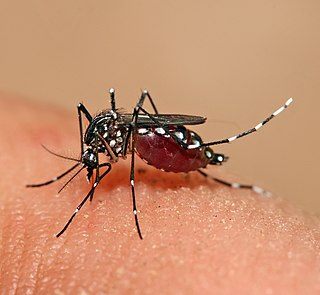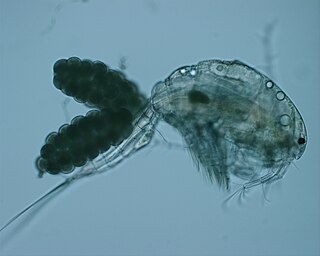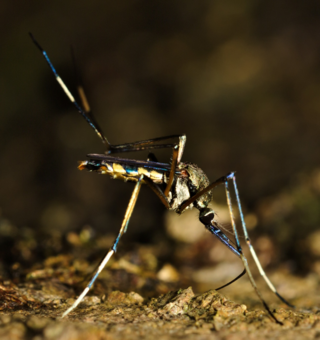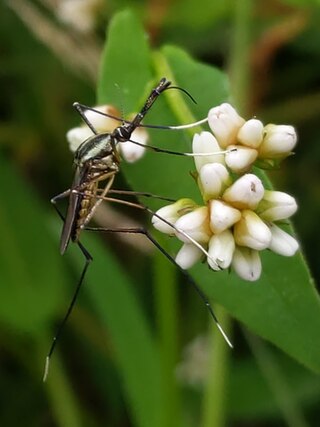
Aedes albopictus, from the mosquito (Culicidae) family, also known as the (Asian) tiger mosquito or forest mosquito, is a mosquito native to the tropical and subtropical areas of Southeast Asia. In the past few centuries, however, this species has spread to many countries through the transport of goods and international travel. It is characterized by the white bands on its legs and body.

Aedes is a genus of mosquitoes originally found in tropical and subtropical zones, but now found on all continents except Antarctica. Some species have been spread by human activity: Aedes albopictus, a particularly invasive species, was spread to the Americas, including the United States, in the 1980s, by the used-tire trade.

Toxorhynchites, also called elephant mosquito or mosquito eater, is a genus of diurnal and often relatively colorful mosquitoes, found worldwide between about 35° north and 35° south. Most species occur in forests. It includes the largest known species of mosquito, at up to 18 mm (0.71 in) in length and 24 mm (0.94 in) in wingspan. It is among the many kinds of mosquito that do not consume blood. The adults subsist on carbohydrate-rich materials, such as honeydew, or saps and juices from damaged plants, refuse, fruit, and nectar.

Aedes aegypti, the yellow fever mosquito, is a mosquito that can spread dengue fever, chikungunya, Zika fever, Mayaro and yellow fever viruses, and other disease agents. The mosquito can be recognized by black and white markings on its legs and a marking in the form of a lyre on the upper surface of its thorax. This mosquito originated in Africa, but is now found in tropical, subtropical and temperate regions throughout the world.

Mosquito control manages the population of mosquitoes to reduce their damage to human health, economies, and enjoyment. Mosquito control is a vital public-health practice throughout the world and especially in the tropics because mosquitoes spread many diseases, such as malaria and the Zika virus.

Nepenthesinfauna are the organisms that inhabit the pitchers of Nepenthes plants. These include fly and midge larvae, spiders, mites, ants, and even a species of crab, Geosesarma malayanum. The most common and conspicuous predators found in pitchers are mosquito larvae, which consume large numbers of other larvae during their development. Many of these animals are so specialised that they cannot survive anywhere else, and are referred to as nepenthebionts.

The Culicinae are the most extensive subfamily of mosquitoes (Culicidae) and have species in every continent except Antarctica, but are highly concentrated in tropical areas. Mosquitoes are best known as parasites to many vertebrate animals and vectors for disease. They are holometabolous insects, and most species lay their eggs in stagnant water, to benefit their aquatic larval stage.

Mesocyclops is a genus of copepod crustaceans in the family Cyclopidae. Because the various species of Mesocyclops are known to prey on mosquito larvae, it is used as a nontoxic and inexpensive form of biological mosquito control.

Aedes triseriatus is a member of the true fly order. It is called the eastern tree hole mosquito due to its predilection towards breeding in stagnant water that is found in natural holding containers such as tree holes. It is native to the eastern United States and southern Canada and favors hardwood habitats. It has been found as far south as the Florida Keys, as far west as Idaho and Utah, and as far north as Quebec and Ontario. This species has not yet been found in Europe, but it has the potential to spread through international trade. In 2004, it was found in a shipment of tires travelling from Louisiana to France, but it was identified and targeted with insecticides that truncated its spread. It is a known vector of La Crosse encephalitis and canine heartworm disease. In the laboratory, it has been found to vector several other viruses including yellow fever, eastern encephalitis, Venezuelan encephalitis, and western encephalitis. Because of its potential for international spread and its proclivity for transmitting disease, monitoring the distribution of this species is essential.

Hydrachnidia, also known as "water mites", Hydrachnidiae, Hydracarina or Hydrachnellae, are among the most abundant and diverse groups of benthic arthropods, composed of 6,000 described species from 57 families. As water mites of Africa, Asia, and South America have not been well-studied, the numbers are likely to be far greater. Other taxa of parasitengone mites include species with semi-aquatic habits, but only the Hydracarina are properly subaquatic. Water mites follow the general Parasitengona life cycle: active larva, inactive (calyptostasic) protonymph, active deutonymph, inactive tritonymph and active adult. Usually, larvae are parasites, while deutonymphs and adults are predators.
Aedes australis is a brackish water mosquito species from the subgenus Halaedes. It is native to Australia. It was first found in New Zealand in 1961 and is now present in the southern half of the South Island.

Bradinopyga geminata is a species of dragonfly in the family Libellulidae known commonly as the granite ghost. It is native to India, Sri Lanka and Thailand, where it is a common and widespread species.
Aedes africanus is a species of mosquito that is found on the continent of Africa with the exclusion of Madagascar. Aedes aegypti and Aedes africanus are the two main yellow fever vector species in Zambia. Aedes africanus is mainly found in tropical forests not near wetlands.

Aedes japonicus, commonly known as the Asian bush mosquito or the Asian rock pool mosquito, was first described by Theobald in 1901 from Tokyo, Japan. They are competent arbovirus vectors known to transmit the West Nile virus as well as Japanese and St. Louis encephalitis. They are listed as an invasive species by the Global Invasive Species Database.
Mesocyclops aspericornis is a freshwater copepod species in the genus Mesocyclops found in the tropics. It was collected from Sumatra, Singapore and Hawaii.
Aedes pipersalatus is a species complex of mosquito belonging to the genus Aedes. It is found in Sri Lanka, Cambodia, West Pakistan, India, and Thailand. It is a non-vector mosquito species, that can be found from rice field and marshland habitats.
Toxorhynchites minimus is a species of zoophilic mosquito belonging to the genus Toxorhynchites. It is found in India, Sri Lanka Indonesia, Malaysia, Philippines and Sumatra. When under mass rearing conditions, the larvae show cannibalism.

Toxorhynchites (Toxorhynchites) splendens is a species of non-hematophagous mosquito belonging to the genus Toxorhynchites. It is widely used as a predator to control dengue mosquitoes.

Toxorhynchites rutilus, also known as the elephant mosquito or treehole predatory mosquito, is a species of mosquito in the family Culicidae. Unlike most species in the genus that populate the tropics, Tx. rutilus is endemic to temperate regions. As their name suggests, these mosquitoes commonly lay their eggs in treeholes where their larvae are predators on a variety of arthropods. As with other mosquitoes, they also inhabit other bodies of stagnant water such as in a tire or artificial containers. but not large bodies of water like ponds and ground pools. Females are able to strategically locate breeding sites that already contain prey to oviposit in.















